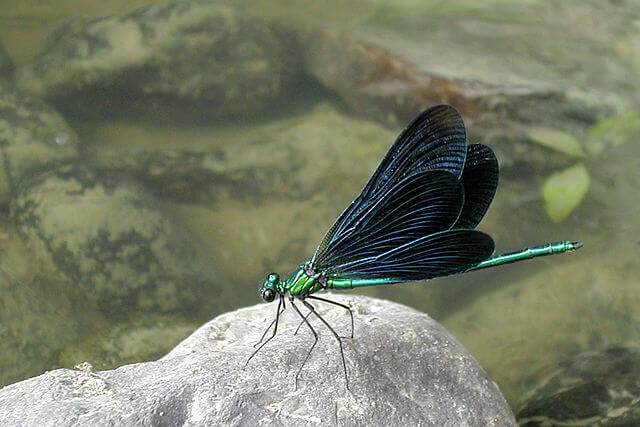
In France, the damselfly in trouble once more after miraculous recovery.
After being absent for 133 years, the damselfly’s return to France in 2009 was regarded as a minor miracle.
However, the dragonfly’s smaller cousin hasn’t been seen in four years, raising new concerns that it may be extinct forever—a worrying sign of the state of the world’s precious breeding wetlands.
There are many threats to damselflies. They live in wetlands and jungles that are frequently cleared in Asia for crops like palm oil. Their natural habitats are demolished in Latin America to construct offices and houses.
The greatest threats have come from pollutants, pesticides, and climate change in North America and Europe.
Therefore, when the Nehalennia speciosa damselfly was discovered for the first time since 1876 in wetlands in the Jura region of eastern France, scientists were ecstatic and referred to the rediscovery as an “ecological scoop.”
However, according to naturalist Francois Dehondt, that recovery was probably only a “remission from the collapse that our biodiversity is suffering.”
Experts are concerned that there may not be a second appearance given the severe drought that engulfed the Jura in 2019 at the time of the last confirmed sighting.
“The water source that shelters the insect was reduced to nothing” by drought, Dehondt wrote in France’s Le Monde newspaper in December.
The water levels remained low in 2020. The bogs of the Jura, where around a dozen damselflies had been observed in 2009, saw some water return the following year.
The region was once more dry after the hottest year on record in France occurred last year.
There were no damselflies around.
The untrained eye might mistake the Nehalennia speciosa for a dragonfly because of its thin, bamboo-like green-blue body and delicate, translucent wings.
However, Europe’s smallest damselflies are difficult to spot because they are only about 25 millimeters (less than an inch) long, unable to fly as well, and frequently require being shaken from bushes in order to be observed.
According to the International Union for the Conservation of Nature (IUCN), 16% of the world’s 6,016 species of damselflies and dragonflies face extinction. The damselfly is considered “critically endangered” in France.
Damselflies are monitored by France’s Office for Insects and their Environment (OPIE), which believes the subspecies has returned.
“Given the state of environmental degradation and drought that we have seen for years, (the likelihood of seeing a damselfly in the Jura) is really very compromised,” OPIE’s Xavier Houard told AFP.
“The warning lights are red.But it’s too soon to be completely certain,” he added.
After 25 years of “non-observation” and extensive searches, the agency will only confirm a species’ “proven disappearance.”
Houard has also not given up hope yet.
“The species has already demonstrated its ability to pass under the radar of observers” for over a century, he said.
The fact that France’s damselflies have vanished adds to the vulnerability of the country’s wetlands, which is a reality throughout Europe and the entire world.
“Globally, these ecosystems are disappearing three times faster than forests,” IUCN director general Bruno Oberle said in 2021 when the organisation updated its Red List of Threatened Species.
According to the Ramsar Convention on Wetlands, an estimated 64% of the world’s wetlands, which include lakes, rivers, marshes, lagoons, and peat bogs, have disappeared since 1900.
The wellbeing of the planet depends on wetland areas. They provide clean water and food in addition to storing 25% of the world’s carbon. The United Nations estimates that wetlands are home to up to 40% of the world’s species, where they live and breed.
However, a quarter of them face extinction.
On Thursday, World Wetlands Day, the United Nations declared that by 2030, 50% of destroyed wetlands must be restored.
Houard claims that the damselfly’s presence is “a wonderful indicator…of the health of wetlands” and that French researchers continue to look for it.
He went on to say that their disappearance would be nothing short of an “alarm bell.”
——————————————————————————
At Natural World Fund, we are passionate about stopping the decline in our wildlife.
The declines in our wildlife is shocking and frightening. Without much more support, many of the animals we know and love will continue in their declines towards extinction.
When you help to restore a patch of degraded land through rewilding to forests, meadows, or wetlands, you have a massive impact on the biodiversity at a local level. You give animals a home and food that they otherwise would not have had, and it has a positive snowball effect for the food chain.
We are convinced that this is much better for the UK than growing lots of fast-growing coniferous trees, solely to remove carbon, that don’t actually help our animals to thrive.
This is why we stand for restoring nature in the UK through responsible rewilding. For us, it is the right thing to do. Let’s do what’s right for nature!
Support our work today at https://naturalworldfund.com/ and join in the solution!

